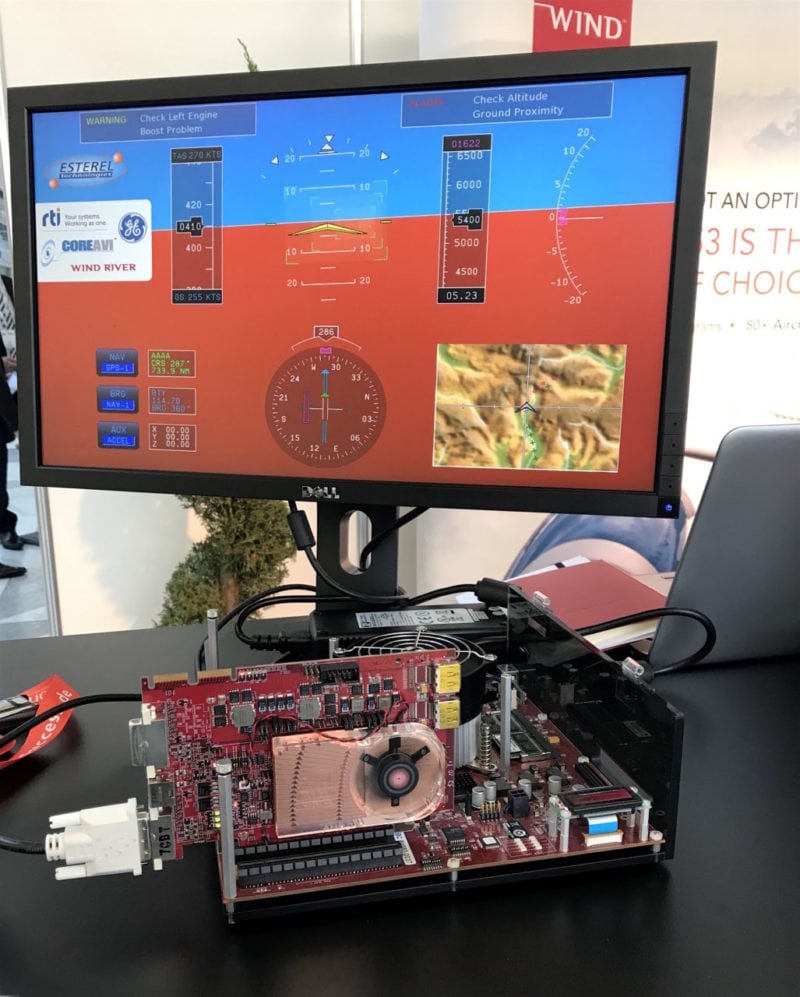
Wind River cockpit display development technology at Aviation Electronics Europe 2017.
With a total of 50 exhibitors, seven panel discussions, four workshops and two certified training courses on DO-178C and DO-254, Europe’s biggest avionics industry event, Aviation Electronics Europe 2017, concluded Wednesday. While it would be impossible to give an overview of all of the avionics-intensive presentations, learnings and keynote speeches from the two-day event in Munich, here are three key lessons we learned.
Standards Help Address Evolving Cyber Threats
One of the biggest cybersecurity threats associated with digital networks and information systems for any industry is hackers always evolving their concepts. What that means is that avionics suppliers and the commercial aviation industry as a whole will continuously be a need to evolve their strategies to protect aircraft from intrusion and to manage the risks associated with their hardware and software.
As noted by Alex Wilson, director of business development for the aerospace and defense division at Wind River, during a panel discussion on cybersecurity and data communications, the risk assessment for an avionics airframe cannot stop at the introduction of the system to the aircraft. It has to be constantly monitored, maintained and updated to ensure it combats the latest threats.
“It’s not just about including security on our avionics systems when we put it on the aircraft, it’s also about securing it throughout that entire life cycle,” said Wilson. “How do we secure that system throughout its life cycle? The framework for doing this is well defined in DO-356.”
The Wind River engineer was referring to the Radio Technical Commission for Aeronautics (RTCA) Special Committee 216’s document released in 2014 — DO-356. The standard addresses type-certification considerations during the first three life-cycle stages of an aircraft type, including initiation, development or acquisition, and implementation. Wilson also referred to DO-355, which provides a framework for activities that need to be performed in the operation and maintenance of the aircraft related to information security threats, according to RTCA.
The main lesson learned from the panel “Data Comms & Cyber Security Perspectives” was that there are some well-established basic protocols that the aviation electronics community could follow to ensure the cybersecurity protection featured on their aircraft constantly evolves to meet the evolving external threat posed by hackers.
ACARS over IP is More Complicated Than it Sounds
The concept of Aircraft Communications Addressing and Reporting System (ACARS) running over internet protocol (IP) can be achieved by leaving the historical structure of ACARS in place, while using an ACARS aircraft gateway to take the ARINC 429 avionics data transfer standard and interface that to IP, and then use IP to deliver the specified message to the ACARS network service provider, SITA or Rockwell Collins. Today this can be achieved by using Iridium’s short burst data network or Inmarsat’s SwiftBroadband Safety service.
But while it is achievable, it’s certainly not widespread. The use of IP will not completely replace ACARS any time soon, according to Philippe Lievin, an engineer who serves as the commercial systems marketing director for Rockwell Collins in France. During the “Data Comms & Cyber Security Perspectives” panel, its chair — Willie Cecil, aircraft data and connectivity systems specialist for Uptake — explained the complexity involved with ACARS over IP.
“Today everyone is asking for IP, for more bandwidth,” said Lievin. “Yes, ACARS is slow; it’s old, but it works and is dispatching airlines the way it has for more than 30 years. A lot of airlines are using this network, therefore I cannot just shut down this network and start operating with IP V6 with cloud everywhere; it’s not that easy. There are more challenges that still need to be addressed before it can become widespread and easy to deploy the way the airlines want.”
Considering how data-intensive new aircraft such as the Airbus A350 and A320neo, and Boeing 787 and 737 MAX are becoming, airlines are seeking to move more of their operational data over a link with more bandwidth.
“ACARS is existing, it’s secure, it works, but it’s very low bandwidth and very, very expensive,” said Marc Mautref, pilots and aircraft connectivity manager for Air France. “We want to move as much as data as possible from ACARS to IP, but we need to have the same quality of service in place.”
RNP to XLS is Coming
The European Aviation Safety Agency (EASA) is requiring European airports with instrument runway ends where there are currently only non-precision approach procedures to publish required navigation performance (RNP) procedures by Jan. 1, 2024.
On the “Cockpit and Avionics Functions and Innovations” panel, several engineers discussed innovations and concepts that are around the corner and could soon become a reality in flight operations. The concept of RNP to XLS, or connecting RNP approaches to ground-based augmentation system (GBAS), satellite-based augmentation system (SBAS) or traditional instrument landing system (ILS) procedures was presented by Thomas Maier, an engineer for the air traffic management division of Airbus.
The Airbus XLS concept proposes connecting ILS, GBAS or SBAS signals and the flight-management computer to an aircraft multi-mode receiver to provide similar flight control laws and guidance modes to what pilots are familiar with seeing when performing an ILS.
According to Maier’s presentation, advanced RNP procedures were tested and validated during 67 flight trials over the past two years as part of the Augmented Approaches to Land (AAL) project lead by NetJets Europe, with Maier noting during his presentation that “67 flight trials are a good starting point” and that further research on the concept of RNP to XLS will help to familiarize pilots and controllers with it and make it more widespread in Europe and around the world.